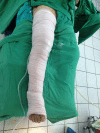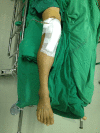Can a modified Robert Jones bandage after knee arthroplasty reduce blood loss? A prospective randomized controlled trial
- PMID: 23307631
- PMCID: PMC3613516
- DOI: 10.1007/s11999-013-2786-0
Can a modified Robert Jones bandage after knee arthroplasty reduce blood loss? A prospective randomized controlled trial
Abstract
Background: A bulky compression dressing (Robert Jones bandage) is commonly used after TKA to reduce blood loss, pain, and swelling. However, it is unclear whether these dressings in fact reduce blood loss.
Questions/purposes: We compared postoperative blood loss, pain, knee swelling, and postoperative complications in two types of postoperative dressings after TKA: a modified Robert Jones dressing (MRJB) and a conventional wound dressing.
Methods: We conducted a prospective, randomized, controlled trial of 60 patients who underwent a unilateral primary TKA at our institution between November 2010 and July 2011. After wound closure, the patients were allocated into two groups. Thirty patients had the MRJB applied for 24 hours (Group 1) and 30 patients had a conventional wound dressing applied (Group 2). Postoperative hemorrhages in the vacuum drain, units of transfused blood, postoperative pain, knee swelling, and complications were assessed at 24 and 48 hours postoperatively.
Results: We found no differences in the mean postoperative blood loss between the groups (Group 1, 418 mL versus Group 2, 467 mL). Blood transfusion amounts, postoperative pain, and knee swelling also were similar. Three patients in Group 1 experienced bruising and two patients in Group 2 also had bruising. One patient in Group 1 had a blister.
Conclusions: Although previous studies have shown reduced blood loss, pain, and knee swelling after application of a MRJB, we found no benefit of this bandage. Our data suggest a postoperative compression dressing is not necessary after primary TKAs.
Figures
Similar articles
-
Modified Robert Jones Bandage in reducing blood loss in total knee arthroplasty: A meta-analysis of randomized controlled trials.Medicine (Baltimore). 2021 Sep 17;100(37):e27156. doi: 10.1097/MD.0000000000027156. Medicine (Baltimore). 2021. PMID: 34664841 Free PMC article.
-
Modified Robert Jones bandage can not reduce invisible blood loss after total knee arthroplasty: a randomized-controlled trial.Arch Orthop Trauma Surg. 2018 Aug;138(8):1151-1157. doi: 10.1007/s00402-018-2978-x. Epub 2018 Jun 22. Arch Orthop Trauma Surg. 2018. PMID: 29931392 Clinical Trial.
-
Does an Elastic Compression Bandage Provide Any Benefit After Primary TKA?Clin Orthop Relat Res. 2019 Jan;477(1):134-144. doi: 10.1097/CORR.0000000000000459. Clin Orthop Relat Res. 2019. PMID: 30794237 Free PMC article. Clinical Trial.
-
Modified Robert Jones bandage can not reduce postoperative swelling in enhanced-recovery after primary total knee arthroplasty without intraoperative tourniquet: a randomized controlled trial.BMC Musculoskelet Disord. 2018 Oct 5;19(1):357. doi: 10.1186/s12891-018-2281-6. BMC Musculoskelet Disord. 2018. PMID: 30290765 Free PMC article. Clinical Trial.
-
The efficacy and safety of modified Robert Jones bandage in total knee arthroplasty: A meta-analysis of randomized-controlled trials.Int J Surg. 2019 Mar;63:22-33. doi: 10.1016/j.ijsu.2019.01.015. Epub 2019 Jan 30. Int J Surg. 2019. PMID: 30708062 Review.
Cited by
-
Short-stretch inelastic compression bandage in knee swelling following total knee arthroplasty study (STICKS): study protocol for a randomised controlled feasibility study.Trials. 2015 Mar 11;16:87. doi: 10.1186/s13063-015-0618-0. Trials. 2015. PMID: 25873152 Free PMC article. Clinical Trial.
-
Modified Robert Jones Bandage in reducing blood loss in total knee arthroplasty: A meta-analysis of randomized controlled trials.Medicine (Baltimore). 2021 Sep 17;100(37):e27156. doi: 10.1097/MD.0000000000027156. Medicine (Baltimore). 2021. PMID: 34664841 Free PMC article.
-
STICKS study - Short-sTretch Inelastic Compression bandage in Knee Swelling following total knee arthroplasty - a feasibility study.Trials. 2017 Jan 9;18(1):6. doi: 10.1186/s13063-016-1767-5. Trials. 2017. PMID: 28069060 Free PMC article. Clinical Trial.
-
Multimodal Peri-articular Injection with Tranexamic Acid can reduce postoperative blood loss versus Intravenous Tranexamic Acid in Total Knee Arthroplasty: A Randomized Controlled Trial.J Orthop Surg Res. 2021 Sep 3;16(1):546. doi: 10.1186/s13018-021-02685-y. J Orthop Surg Res. 2021. PMID: 34479593 Free PMC article. Clinical Trial.
-
Peri-articular tranexamic acid injection in total knee arthroplasty: a randomized controlled trial.BMC Musculoskelet Disord. 2016 Jul 26;17:313. doi: 10.1186/s12891-016-1176-7. BMC Musculoskelet Disord. 2016. PMID: 27455842 Free PMC article. Clinical Trial.
References
-
- Brodell JD, Axon DL, Evarts CM. The Robert Jones bandage. J Bone Joint Surg Br. 1986;68:776–779. - PubMed
-
- DeLoach LJ, Higgins MS, Caplan AB, Stiff JL. The visual analog scale in the immediate postoperative period: intrasubject variability and correlation with a numeric scale. Anesth Analg. 1998;86:102–106. - PubMed
-
- Denis M, Moffet H, Caron F, Ouellet D, Paquet J, Nolet L. Effectiveness of continuous passive motion and conventional physical therapy after total knee arthroplasty: a randomized clinical trial. Phys Ther. 2006;86:174–185. - PubMed
Publication types
MeSH terms
LinkOut - more resources
Full Text Sources
Other Literature Sources
Medical



